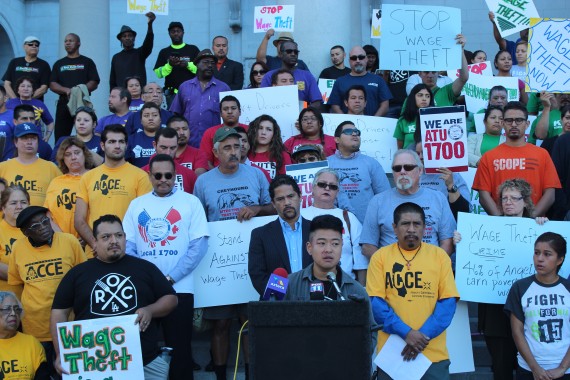Annie Hollister is an Honors Attorney at the U.S. Department of Labor and an alumna of Harvard Law School.
Immigration and Customs Enforcement (ICE) detention centers are the nation’s largest employer of immigrant labor. According to the New York Times at least 60,000 immigrants every year work in detention centers through federally-authorized “Voluntary Work Programs.” In this capacity, immigrants detained across the United States prepare meals for, clean, and maintain the facilities in which they are held. Wages for this work are uniform: per agency guidelines, detained laborers are paid $1 per day, regardless of the number of hours worked. The result is an average pay of about 13 cents per hour.
The Voluntary Work Program is not new. Congress initially authorized federal agencies to pay detained immigrants for labor in 1950; the dollar-a-day rate ostensibly comes from the appropriations bill that accompanied that authorization. The program in its current form is outlined in ICE’s “Performance-Based National Detention Standards” (PBNDS), effectively an operations manual for ICE detention centers. The guidelines describe the Voluntary Work Program as an “opportunit[y]” for detainees to “work and earn money while confined.” The program is voluntary in that individuals detained in ICE centers are not legally required to work. But some detainees say that the program is voluntary in name only. Those who refuse to participate may be put in solitary confinement or reassigned to undesirable housing units. Furthermore, essential items like toothpaste and toilet paper are only available through purchase from the detention center commissary—and the Voluntary Work Program is the only source of income available to detainees.
In the last several years, detainees, activists, and state governments have filed a slew of lawsuits attacking the Voluntary Work Program and its dollar-a-day pay scale. Many of these suits have targeted private companies that run detention centers through contracts with ICE. Of the roughly 52,000 immigrants detained at any one time, more than 70% are held in facilities operated by private corporations. For the most part, those facilities are operated by two companies: GEO Group and CoreCivic.
Plaintiffs challenging the Voluntary Work Program have had to work around unfavorable precedent. In a case from the early 1990s, Guevara v. INS, the Fifth Circuit held that immigration detainees are not “employees” and are therefore exempt from coverage under the Fair Labor Standards Act. As a result, litigants have deployed a patchwork of legal strategies drawing on state minimum wage statutes, federal anti-trafficking law, and private law claims of unjust enrichment. In this uncertain landscape, privately-run centers are attractive targets for litigation because suits against them, unlike those against public entities, are not limited by statute or by sovereign immunity.
Plaintiffs have had some success challenging Voluntary Work Programs under state minimum wage laws and under the federal Trafficking Victims Protection Act (TVPA). These statutory challenges are promising, but have some drawbacks. State wage laws are highly variable and typically require plaintiffs to show that they are “employees”—a test that the Fifth Circuit found that detained immigrants failed in Guevara. Likewise, the TVPA provides a relatively narrow path to success. In order to prevail, workers must show that detention centers obtained labor through actual or threatened force, serious harm, or abuse of the legal process. While some detained workers do claim that they were coerced into working, many do not. And success under the TVPA would vindicate only those plaintiffs who allege coercion, without striking at the legitimacy of the Voluntary Work Program itself.
In several ongoing cases, detained workers also raised claims that private companies operating detention facilities are unjustly enriched by the exploitation of detainee labor. This line of argument provides an intriguing complement to plaintiffs’ statutory claims. The doctrine of unjust enrichment is both broad and relatively under-theorized, but its premise is simple: a defendant is unjustly enriched if it (1) receives a benefit (2) at the plaintiff’s expense, and (3) the circumstances are such that retaining that benefit would be unjust.
Private detention centers undoubtedly receive a benefit at the expense of detainees. By employing detained immigrants to perform essential labor, private companies retain enormous savings. Take GEO Group’s Colorado operations as an example: under GEO’s contract with ICE, the lowest allowable wage for non-detainee labor at the company’s Aurora facility was $10.90 per hour when litigation commenced. By paying workers $1 per day, GEO by one estimate was able to save more than $120,000 per month in labor costs.
It is the third prong, of course, that does the heavy lifting: what constitutes “unjust” circumstances is inherently a subjective decision. But a few aspects of unjust enrichment doctrine weigh in the plaintiffs’ favor. First, unlike the TVPA, unjust enrichment does not require a showing of egregious wrongdoing or coercion by the defendant. Rather, it requires only a showing that it would be unjust for the defendant to retain the contested benefit—even if, for instance, the defendant received the benefit because of a good-faith error.
Second, the most recent relevant Restatement defines unjust enrichment as “enrichment that lacks an adequate legal basis.” At least one federal court has found that, although initial authorization for employing detained immigrants was established by federal statute, the current program has no basis in law. The ostensible authorizing statute predated the creation of ICE by several decades, and in the years since ICE was established, Congress has never authorized the agency to promulgate rules relating to employing detainees. Detention centers point to the PBNDS as the sole source of authority for today’s Voluntary Work Programs. But, as a district judge pointed out in Nwauzor v. GEO Group, the PBNDS are merely “ICE policy with no . . . force at law.”
Finally, courts have repeatedly found that unpaid wages can constitute unjust enrichment. And where plaintiffs succeed on unjust enrichment claims related to unpaid wages, they often find themselves in a stronger position than if they had succeeded under a statutory minimum wage claim. While damages in a statutory wage claim would be capped at minimum wage for hours worked, restitution for unjust enrichment is based on the fair market value of the labor performed. Recently, a federal court in Pennsylvania awarded more than $4.5m to a class of exotic dancers who had been misclassified as independent contractors. The dancers won on both statutory minimum wage and unjust enrichment grounds. Although the damages for the minimum wage claim were substantial, restitution for the unjust enrichment claim nearly doubled the award.
At least two suits challenging Voluntary Work Programs on unjust enrichment grounds are currently scheduled for trial, having survived motions to dismiss. And unlike success on a state statutory claim, which is jurisdiction-specific, or the TVPA, which would be limited to plaintiffs who can show actual coercion, success on an unjust enrichment claim would cast a shadow on the legitimacy of the Voluntary Work Program as a whole.
This could have serious implications. GEO Group and CoreCivic operate facilities all across the country. Within those facilities, tens of thousands of workers perform essential labor for private entities at wages nowhere near federal and state minimums, under a scheme that has no foundation in law. The ongoing suits, and unjust enrichment claims in particular, present a promising path toward holding those businesses to account for their exploitation of immigrant labor.









Daily News & Commentary
Start your day with our roundup of the latest labor developments. See all
April 19
Alabama and Louisiana advance anti-worker legislation; Mercedes workers in Alabama set election date; VW Chattanooga election concludes today.
April 18
Disneyland performers file petition for unionization and union elections begin at Volkswagen plant in Tennessee.
April 18
In today’s Tech@Work, a regulation-of-algorithms-in-hiring blitz: Mass. AG issues advisory clarifying how state laws apply to AI decisionmaking tools; and British union TUC launches campaign for new law to regulate the use of AI at work.
April 17
Southern governors oppose UAW organizing in their states; Florida bans local heat protections for workers; Google employees occupy company offices to protest contracts with the Israeli government
April 16
EEOC publishes final regulation implementing the Pregnant Workers Fairness Act, Volkswagen workers in Tennessee gear up for a union election, and the First Circuit revives the Whole Foods case over BLM masks.
April 15
The Supreme Court ruled in favor of bakery delivery drivers in an exemption from mandatory arbitration case; A Teamsters Local ends its 18-month strike by accepting settlement payments and agreeing to dissolve